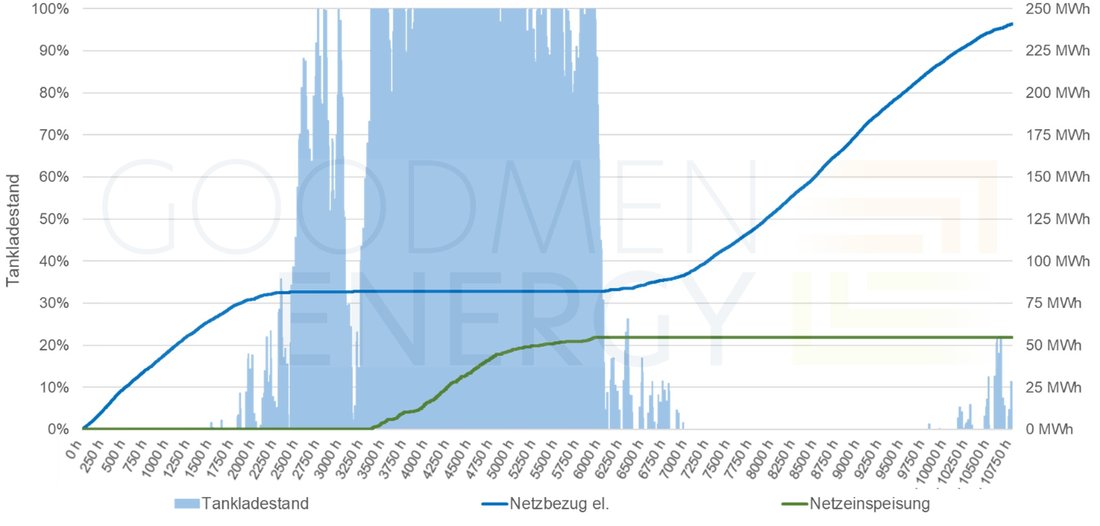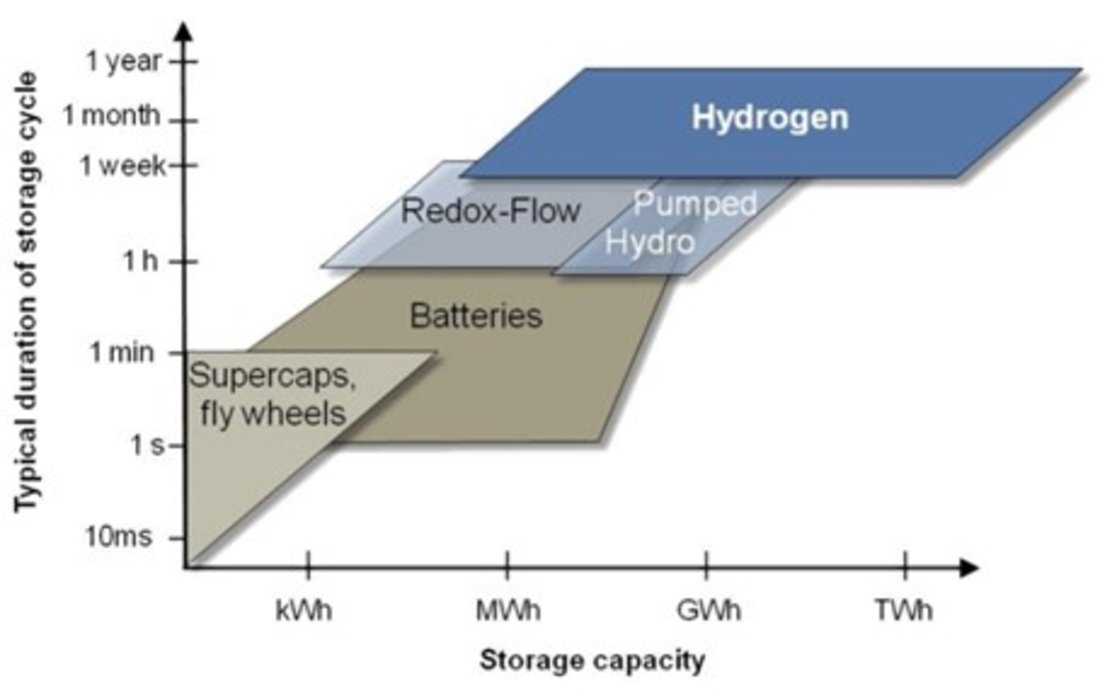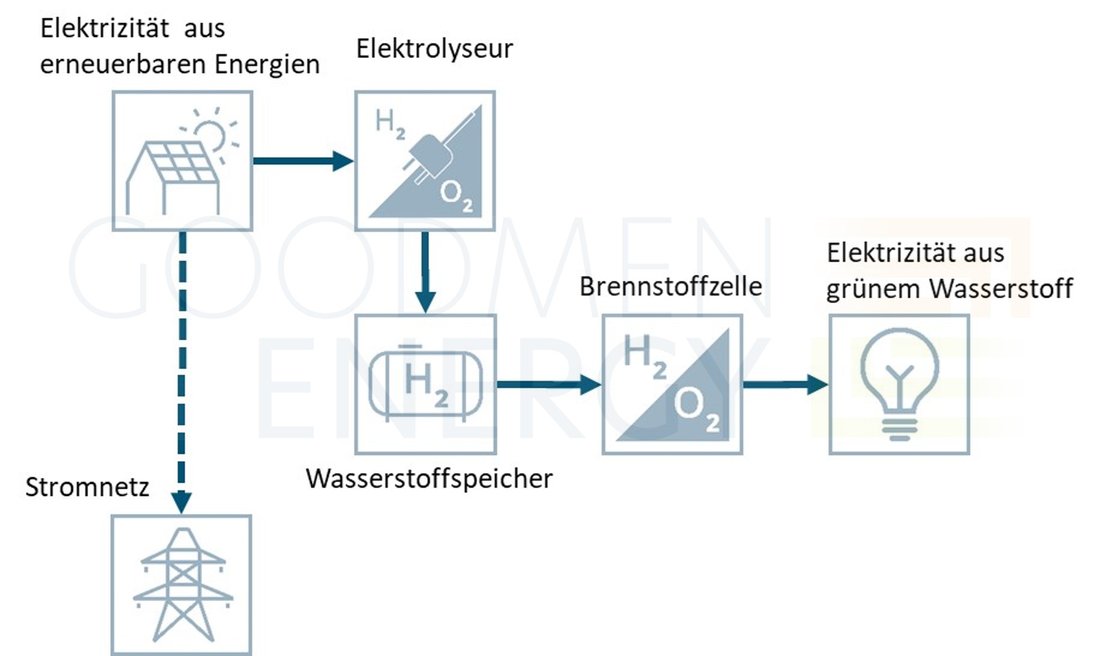Benefits and feasibility of storing renewable energies using hydrogen
Local surpluses
The consequent widespread use of sustainable energy technology such as photovoltaics, wind power and solar thermal systems is characterized by seasonal and fluctuating influences. This leads, among other things, to a surplus of electricity on sunny days that has to be fed into the electricity grid due to the lack of storage facilities. As long as this local surplus can be distributed regionally and supraregionally, the option is ecologically and economically sensible. From the point of view of the plant operator, however, at times when the electrical energy is actually needed, it must be drawn from the grid again at the most unfavorable conditions.
Since in the future a large part of the electricity and heat demand from sustainable energy will be covered by wind power, PV and solar thermal systems, a high residual load* is to be expected. Therefore, a combination of all types of renewable energy sources with decentralized and centralized storage systems is mandatory to ensure sufficient supply security. Hydrogen will play an important role as an energy carrier that can be used for long-term storage.
Figure 1 shows that hydrogen has good prerequisites in terms of long storage duration and large storage capacity. Thus, if one wants to maximize the electricity self-consumption for economic reasons, larger storage capacities (order of magnitude weeks to months) are target-oriented. The storage of large amounts of energy in the form of hydrogen is particularly feasible and inexpensive (this does not apply to the conversion of electricity to hydrogen to electricity).
Power2Gas2Power: Storage hydrogen
A classic approach to this is the "Power to Gas to Power" (P2G2P) process. For this purpose, any surplus electricity generated by photovoltaics, for example, is converted into hydrogen by an electrolyzer and temporarily stored in a local hydrogen tank. If required, this can be converted back into electrical energy via a fuel cell and then made available. Figure 2 schematically illustrates such a process.
This setup also offers the possibility of sector coupling. In this case, the electrical energy generated can be used, among other things, to supply electricity to a heat pump, which in turn provides hot and heating water. In addition, it is also possible to use the waste heat generated by the P2G2P process to supply energy.
Hydrogen storage: Current challenges
Despite the numerous advantages of storing surplus electricity using hydrogen, there are also some feasibility challenges to overcome. The biggest hurdle is currently the economic viability, which would doom the implementation of a hydrogen storage project to failure. The cost drivers primarily include the expenses for the electrolyzer and fuel cell. This is mainly due to the high cost of materials and production.However, scientists expect a cost reduction of up to 50 % by 2030. In order to achieve better economic efficiency at the current time, funding programs from the state, federal government and the European Union could be helpful.
Hydrogen production and storage also has some space requirements, depending on the size of the plant, which in housing developments can result in losses from space not being used and rented or sold.
To ensure successful implementation of a project, organizational feasibility should also not be neglected. Due to the novel technology application of hydrogen storage, a specialized expertise on a technical, economic and legal basis is elementary.

goodmen energy: We hold the expertise for your project
At goodmen energy, we not only have the necessary expertise in hydrogen technology, we can also dynamically model and represent all customer-specific applications. The following graphics illustrate the simulation of an example project:
Into the future with us
Despite the challenges still to be solved, the storage of excess energy from regenerative sources offers the possibility for future projects to supply entire neighborhoods with energy independently and at no cost. With funding, pilot projects can already be implemented today.
Let's take an important step into the future together and make our contribution to saving our climate.
* The term residual load describes the part of electricity consumption in Germany that remains after deducting the feed-in of fluctuating renewable energies into the power grid. In other words, it refers to the residual demand for electricity that cannot be covered by wind and solar energy. To a large extent, the residual load is covered with the help of the output of conventional energy sources.




